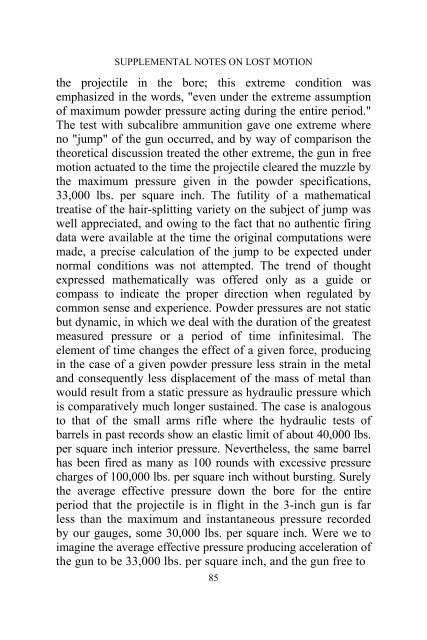the field artillery journal - Fort Sill - U.S. Army
the field artillery journal - Fort Sill - U.S. Army
the field artillery journal - Fort Sill - U.S. Army
You also want an ePaper? Increase the reach of your titles
YUMPU automatically turns print PDFs into web optimized ePapers that Google loves.
SUPPLEMENTAL NOTES ON LOST MOTION<br />
<strong>the</strong> projectile in <strong>the</strong> bore; this extreme condition was<br />
emphasized in <strong>the</strong> words, "even under <strong>the</strong> extreme assumption<br />
of maximum powder pressure acting during <strong>the</strong> entire period."<br />
The test with subcalibre ammunition gave one extreme where<br />
no "jump" of <strong>the</strong> gun occurred, and by way of comparison <strong>the</strong><br />
<strong>the</strong>oretical discussion treated <strong>the</strong> o<strong>the</strong>r extreme, <strong>the</strong> gun in free<br />
motion actuated to <strong>the</strong> time <strong>the</strong> projectile cleared <strong>the</strong> muzzle by<br />
<strong>the</strong> maximum pressure given in <strong>the</strong> powder specifications,<br />
33,000 lbs. per square inch. The futility of a ma<strong>the</strong>matical<br />
treatise of <strong>the</strong> hair-splitting variety on <strong>the</strong> subject of jump was<br />
well appreciated, and owing to <strong>the</strong> fact that no au<strong>the</strong>ntic firing<br />
data were available at <strong>the</strong> time <strong>the</strong> original computations were<br />
made, a precise calculation of <strong>the</strong> jump to be expected under<br />
normal conditions was not attempted. The trend of thought<br />
expressed ma<strong>the</strong>matically was offered only as a guide or<br />
compass to indicate <strong>the</strong> proper direction when regulated by<br />
common sense and experience. Powder pressures are not static<br />
but dynamic, in which we deal with <strong>the</strong> duration of <strong>the</strong> greatest<br />
measured pressure or a period of time infinitesimal. The<br />
element of time changes <strong>the</strong> effect of a given force, producing<br />
in <strong>the</strong> case of a given powder pressure less strain in <strong>the</strong> metal<br />
and consequently less displacement of <strong>the</strong> mass of metal than<br />
would result from a static pressure as hydraulic pressure which<br />
is comparatively much longer sustained. The case is analogous<br />
to that of <strong>the</strong> small arms rifle where <strong>the</strong> hydraulic tests of<br />
barrels in past records show an elastic limit of about 40,000 lbs.<br />
per square inch interior pressure. Never<strong>the</strong>less, <strong>the</strong> same barrel<br />
has been fired as many as 100 rounds with excessive pressure<br />
charges of 100,000 lbs. per square inch without bursting. Surely<br />
<strong>the</strong> average effective pressure down <strong>the</strong> bore for <strong>the</strong> entire<br />
period that <strong>the</strong> projectile is in flight in <strong>the</strong> 3-inch gun is far<br />
less than <strong>the</strong> maximum and instantaneous pressure recorded<br />
by our gauges, some 30,000 lbs. per square inch. Were we to<br />
imagine <strong>the</strong> average effective pressure producing acceleration of<br />
<strong>the</strong> gun to be 33,000 lbs. per square inch, and <strong>the</strong> gun free to<br />
85

















